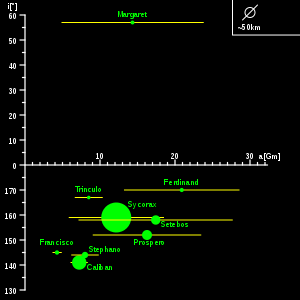Margaret (moon)
Margaret is the only prograde irregular satellite of Uranus. It was discovered by Scott S. Sheppard, et al. in 2003 and given the provisional designation S/2003 U 3.[8]
| Discovery | |
|---|---|
| Discovered by | |
| Discovery date | August 29, 2003[1][2] |
| Designations | |
Designation | Uranus XXIII |
| Pronunciation | /ˈmɑːrɡərɛt/[3] |
| Adjectives | Margaretian[4] |
| Orbital characteristics | |
Mean orbit radius | 14,345,000 km[5][6] |
| Eccentricity | 0.6608[6] (mean) |
| 1687.01 d | |
| Inclination | 57° (to the ecliptic)[5] |
| Satellite of | Uranus |
| Physical characteristics | |
Mean radius | 10 km (estimate)[7] |
| ~1,300 km2 (estimate) | |
| Volume | ~4,200 km3 (estimate) |
| Mass | ~5.5×1015 kg (estimate) |
Mean density | ~1.3 g/cm3 (assumed) |
| ~0.0023 m/s2 (estimate) | |
| ~0.0085 km/s (estimate) | |
| ? | |
| ? | |
| Albedo | 0.04 (assumed)[7] |
| Temperature | ~65 K (estimate) |
Confirmed as Uranus XXIII, it was named after the servant of Hero in William Shakespeare's play Much Ado About Nothing.[1]
Orbit

Margaret stands out as the only prograde irregular satellite of Uranus. The diagram illustrates the orbital parameters of Margaret, unique among the irregular satellites of Uranus, with inclination on the vertical axis and the eccentricity of the orbits represented by the segments extending from the pericentre to the apocentre.
Margaret's inclination of 57° is close to the limit of stability. The intermediate inclinations 60 < i < 140 are devoid of known moons due to the Kozai instability.[9] In this instability region, solar perturbations at apoapse cause the moons in this region to acquire large eccentricities that lead to collisions or ejection over 10 million to a billion years. Margaret's periapsis precession period (Pw) is almost 1.6 million years long.[6] Margaret itself may be ejected from the Uranian system in the far future.[10]
In 2008, Margaret's current eccentricity was 0.7979.[11] This temporarily gives Margaret the most eccentric orbit of any moon in the Solar System, though Nereid's mean eccentricity is greater.
See also
- Uranus' natural satellites
References
- Blue, Jennifer (2008-10-16). "Planet and Satellite Names and Discoverers". Working Group for Planetary System Nomenclature (WGPSN). Retrieved 2008-12-19.
- Sheppard, Scott S. "New Satellites of Uranus Discovered in 2003". Institute for Astronomy at the University of Hawaii. Archived from the original on 5 May 2008. Retrieved 2008-12-19.
- Benjamin Smith (1903) The Century Dictionary and Cyclopedia
- Cathcart (1971) The Duchess of Kent
- Sheppard, Jewitt & Kleyna 2005, p. 523, Table 3.
- Jacobson, R.A. (2003) URA067 (2007-06-28). "Planetary Satellite Mean Orbital Parameters". JPL/NASA. Retrieved 2008-01-23.
- Sheppard, Jewitt & Kleyna 2005, p. 523, Table 3 ... ri (km) ... 10 ... i Radius of satellite assuming a geometric albedo of 0.04.
- IAU Circular 8217
- Sheppard, Jewitt & Kleyna 2005, pp. 524–525.
- Brozovic, M.; Jacobson, R. A. (4 March 2009). "The Orbits of the Outer Uranian Satellites". The Astronomical Journal. 137 (4): 3834–42. Bibcode:2009AJ....137.3834B. doi:10.1088/0004-6256/137/4/3834.
- "IAU-MPC Natural Satellites Ephemeris Service". IAU: Minor Planet Center. Retrieved 2008-01-26. (Select Uranian, deselect Ephemerides and select Orbital Elements)
- Sheppard, S. S.; Jewitt, D.; Kleyna, J. (2005). "An Ultradeep Survey for Irregular Satellites of Uranus: Limits to Completeness". The Astronomical Journal. 129 (1): 518–525. arXiv:astro-ph/0410059. Bibcode:2005AJ....129..518S. doi:10.1086/426329.

